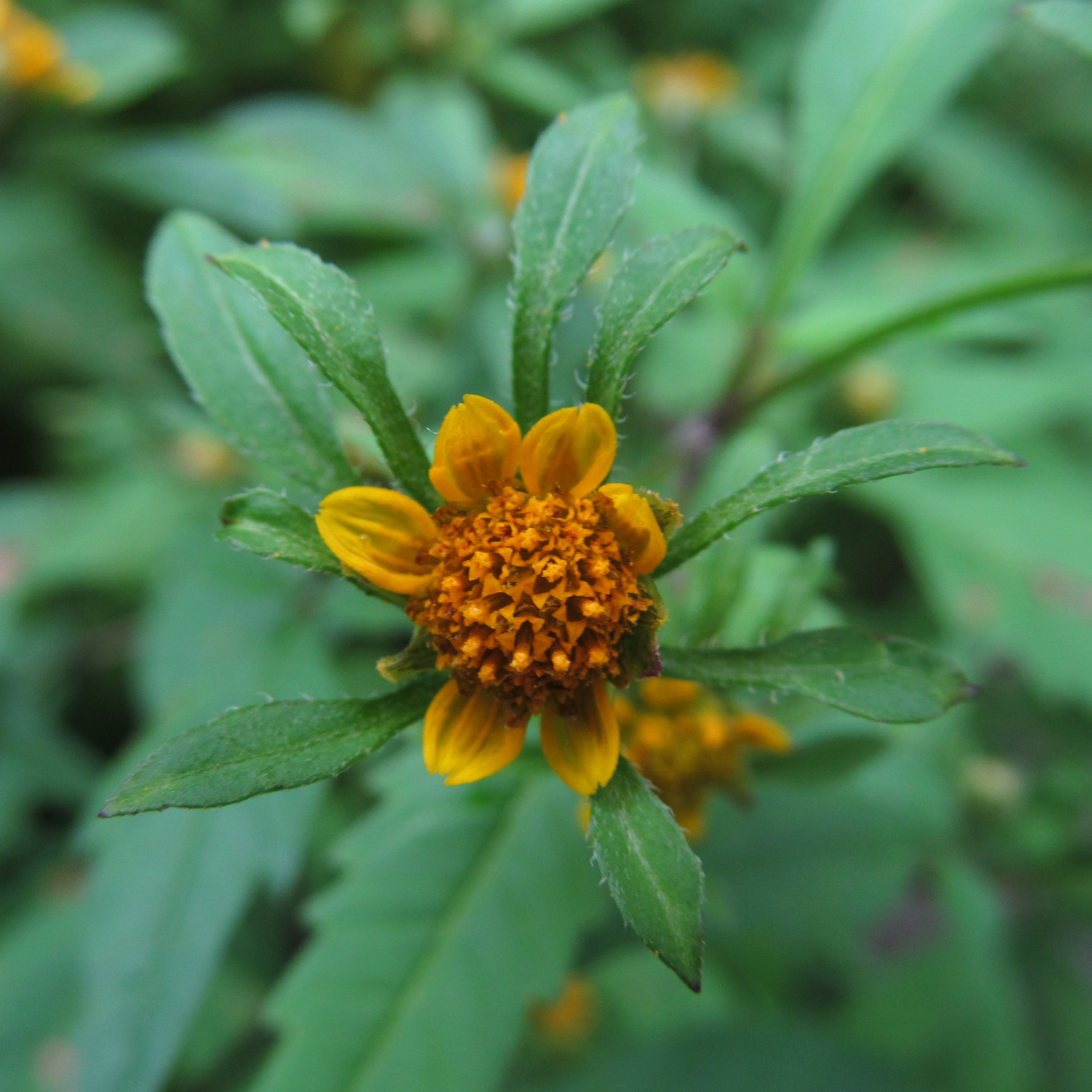Devil's Beggartick on:
[Wikipedia]
[Google]
[Amazon]
''Bidens frondosa'' is a
Flora of North America. It is known in many other parts of the world as an introduced species, including Europe, Asia, Morocco, and New Zealand. Its many common names include devil's beggarticks, devil's-pitchfork, devil's bootjack, sticktights, bur marigold, pitchfork weed, tickseed sunflower,''Bidens frondosa''.
Integrated Taxonomic Information System (ITIS). leafy beggarticks,''Bidens frondosa''.
Burke Museum. University of Washington. and common beggar-ticks.''Bidens frondosa''.
Freckmann Herbarium. University of Wisconsin, Stevens Point.


Virginia Tech Weed Identification Guide. The barbed
CalPhotos photos gallery, University of California
{{Taxonbar, from=Q1560642 frondosa Flora of North America Plants described in 1753 Taxa named by Carl Linnaeus Invasive plant species in Japan
North America
North America is a continent in the Northern Hemisphere and almost entirely within the Western Hemisphere. It is bordered to the north by the Arctic Ocean, to the east by the Atlantic Ocean, to the southeast by South America and the Car ...
n species of flowering plant in the aster family, Asteraceae. It is widespread across much of Canada, the United States, and Mexico''Bidens frondosa''.Flora of North America. It is known in many other parts of the world as an introduced species, including Europe, Asia, Morocco, and New Zealand. Its many common names include devil's beggarticks, devil's-pitchfork, devil's bootjack, sticktights, bur marigold, pitchfork weed, tickseed sunflower,''Bidens frondosa''.
Integrated Taxonomic Information System (ITIS). leafy beggarticks,''Bidens frondosa''.
Burke Museum. University of Washington. and common beggar-ticks.''Bidens frondosa''.
Freckmann Herbarium. University of Wisconsin, Stevens Point.
Ecology and habitat
''Bidens frondosa'' grows best where there is ample soil moisture and sun, especially in areas where something has disrupted the existing plant community leaving bare ground. It can survive in water saturated soils, frequently found growing at the water's edge, in drainage ditches or on flood plains. The defoliatingcaterpillar
Caterpillars ( ) are the larval stage of members of the order Lepidoptera (the insect order comprising butterflies and moths).
As with most common names, the application of the word is arbitrary, since the larvae of sawflies (suborder Sym ...
of '' Hadjina chinensis'', which is limited to ''Bidens'' species, has been observed on this plant.


Morphology
''Bidens frondosa'' is an annual herb, usually growing to tall, but it may reach . The stems are square in cross-section and may branch near the top. The leaves are pinnate, divided into a few toothed triangular or lance-shaped leaflets usually long, exceptionally up to . The inflorescence is often a solitary flower head, but there may be pairs or arrays of several heads. The head contains many orange disc florets. Most flower heads lack ray florets but some may have a few small yellow rays. The fruit is a flat black or brown barbed cypsela up to a centimeter long which has two obvious hornlikepappi
In Asteraceae, the pappus is the modified calyx, the part of an individual floret, that surrounds the base of the corolla tube in flower. It functions as a wind-dispersal mechanism for the seeds. The term is sometimes used for similar s ...
at one end.Devils Beggarticks or Stick-tights: ''Bidens frondosa''.Virginia Tech Weed Identification Guide. The barbed
pappi
In Asteraceae, the pappus is the modified calyx, the part of an individual floret, that surrounds the base of the corolla tube in flower. It functions as a wind-dispersal mechanism for the seeds. The term is sometimes used for similar s ...
on the fruit help it stick to animals, facilitating seed dispersal.
Invasive species
This plant isinvasive
Invasive may refer to:
*Invasive (medical) procedure
*Invasive species
*Invasive observation, especially in reference to surveillance
*Invasively progressive spread of disease from one organ in the body to another, especially in reference to cancer ...
in some parts of the world. In New Zealand it is classed as an environmental weed by the Department of Conservation
An environmental ministry is a national or subnational government agency politically responsible for the environment and/or natural resources. Various other names are commonly used to identify such agencies, such as Ministry of the Environment ...
. It is also weedy in its native range, occurring in pastures and fields and along roadsides.
References
External links
CalPhotos photos gallery, University of California
{{Taxonbar, from=Q1560642 frondosa Flora of North America Plants described in 1753 Taxa named by Carl Linnaeus Invasive plant species in Japan